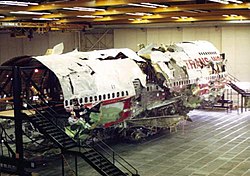
Back تي دبليو إيه الرحلة 800 Arabic Полет 800 на „Транс Уърлд Еърлайнс“ Bulgarian Let TWA 800 Czech Ehediad TWA 800 Welsh TWA Flight 800 Danish Trans-World-Airlines-Flug 800 German Vuelo 800 de TWA Spanish پرواز تیدبلیوای ۸۰۰ Persian TWA:n lento 800 Finnish Vol TWA 800 French
 The reconstructed wreckage of TWA 800, stored by the NTSB at Calverton Executive Airpark | |
| Accident | |
|---|---|
| Date | July 17, 1996 |
| Summary | In-flight breakup due to fuel tank explosion caused by short circuit |
| Site | Atlantic Ocean, near East Moriches, New York, United States 40°39′N 72°38′W / 40.650°N 72.633°W |
| Aircraft | |
| Aircraft type | Boeing 747-131 |
| Operator | Trans World Airlines |
| IATA flight No. | TW800 |
| ICAO flight No. | TWA800 |
| Call sign | TWA 800 |
| Registration | N93119 |
| Flight origin | John F. Kennedy Int'l Airport, New York City, United States |
| Stopover | Paris-Charles de Gaulle Airport, Paris, France |
| Destination | Leonardo da Vinci Airport, Rome, Italy |
| Occupants | 230 |
| Passengers | 212 |
| Crew | 18 |
| Fatalities | 230 |
| Survivors | 0 |
Trans World Airlines Flight 800 (TWA800) was a Boeing 747-100 that exploded and crashed into the Atlantic Ocean near East Moriches, New York, on July 17, 1996, at approximately 8:31 p.m. EDT, 12 minutes after takeoff from John F. Kennedy International Airport, on a scheduled international passenger flight to Rome with a stopover in Paris.[1]: 1
All 230 people on board died in the crash; it is the third-deadliest aviation accident in U.S. history. Accident investigators from the National Transportation Safety Board (NTSB) traveled to the scene, arriving the following morning[1]: 313 amid speculation that a terrorist attack was the cause of the crash.[2][3][4]
The Federal Bureau of Investigation (FBI) and New York Police Department Joint Terrorism Task Force (JTTF) initiated a parallel criminal investigation.[5] Sixteen months later, the JTTF announced that no evidence of a criminal act had been found and closed its active investigation.[6]
The four-year NTSB investigation concluded with the approval of the Aircraft Accident Report on August 23, 2000, ending the most extensive, complex, and costly air disaster investigation in U.S. history at that time.[7][8] The report's conclusion was that the probable cause of the accident was the explosion of flammable fuel vapors in the center fuel tank. Although it could not be determined with certainty, the likely ignition source was a short circuit.[1]: xvi Problems with the aircraft's wiring were found, including evidence of arcing in the fuel quantity indication system (FQIS) wiring that enters the tank. The FQIS on Flight 800 is known to have been malfunctioning; the captain remarked about "crazy" readings from the system about two minutes and 30 seconds before the aircraft exploded. As a result of the investigation, new requirements were developed for aircraft to prevent future fuel-tank explosions.[9]
- ^ a b c "In-flight Breakup Over The Atlantic Ocean, Trans World Airlines Flight 800, Boeing 747-131, N93119, Near East Moriches, New York, July 17, 1996" (PDF). Aircraft Accident Report. National Transportation Safety Board. August 23, 2000. NTSB/AAR-00/03. Archived (PDF) from the original on March 4, 2016. Retrieved January 5, 2016.
- ^ "What happened to Flight 800?". CNN. July 19, 1996. Archived from the original on November 4, 2019. Retrieved April 5, 2011.
- ^ Knowlton, Brian (July 24, 1996). "Investigators Focus Closely on Terrorism As Cause of Explosion: Chemicals Found on Jet Victims, U.S. Reports". The New York Times. ISSN 0362-4331. Archived from the original on February 2, 2017. Retrieved April 5, 2011.
- ^ Fedarko, Kevin; et al. (July 29, 1996). "Terror on Flight 800: Who wishes us ill?". Time. Archived from the original on January 31, 2014. Retrieved April 5, 2011.
- ^ "Aviation and criminal experts probe TWA crash". CNN. July 19, 1996. Archived from the original on June 1, 2019. Retrieved April 5, 2011.
- ^ "FBI: No criminal evidence behind TWA 800 crash". CNN. November 18, 1997. Archived from the original on June 22, 2019. Retrieved April 5, 2011.
- ^ "NTSB Board Meeting on TWA 800 August 23, 2000, Part 4". National Transportation Safety Board. Archived from the original on May 14, 2011. Retrieved April 5, 2011.
- ^ Tauss, Randolph M. (August 14, 2008). "The Crash of TWA Flight 800". Central Intelligence Agency. Archived from the original on August 5, 2011. Retrieved April 6, 2011.
- ^ Lowery, Joan (July 16, 2008). "Jet fuel-tank protection ordered". Seattle Post-Intelligencer. Associated Press. Retrieved April 5, 2011.